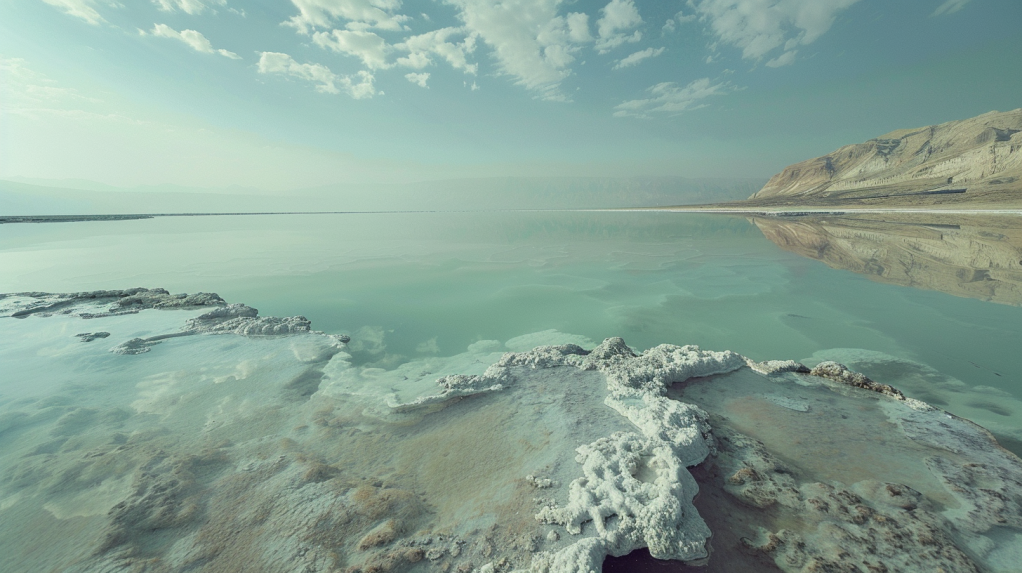The Science behind the Dead Sea

The Dead Sea sparks curiosity in many scientists across the globe. It offers a fascinating case study in the science of geology, hydrology, and environmental studies. This unique saltwater lake, bordered by Jordan to the east and Israel and the West Bank to the west, is renowned for its extreme salinity, a characteristic that defies the norms of freshwater bodies and marine environments alike. The science behind the Dead Sea encompasses the interplay of tectonic activity that formed the Jordan Rift Valley, the climatic conditions leading to its high evaporation rates, and the mineral-rich inflows that contribute to its unparalleled mineral composition. These factors, combined with its historical significance and the ecological challenges it faces today, make the Dead Sea a subject of intense scientific interest. To start, let’s explore the extreme salinity of the Dead Sea.
Why is it called the Dead Sea
Historically, the Dead Sea has been known by various names, but the moniker "Dead Sea" is believed to have been coined due to the noticeable absence of common marine life forms, such as fish and aquatic plants, which cannot thrive in such a saline-rich environment. The water's high mineral content, while prohibiting most life, does support a limited number of microorganisms, such as bacteria and microbial fungi, which have adapted to high-salinity conditions. These extremophiles are an exception to the general rule that the Dead Sea's waters are largely devoid of life.
The name "Dead Sea" has been used in various historical texts and by travellers and explorers who visited the region and noted the lake's unique characteristics. Its other historical names, such as the "Salt Sea" in the Hebrew Bible, also reflect the prominent feature of its high salt content. The Dead Sea's name, therefore, is a testament to its extreme natural conditions, distinguishing it from other bodies of water around the world.
Despite its ominous name, the Dead Sea has been a source of fascination, health, and beauty treatments for thousands of years.
The mineral-rich mud and water are reputed for their therapeutic properties, drawing visitors from around the globe seeking relief from various skin conditions and joint ailments. The Dead Sea's unique environmental conditions have also contributed to its significance in historical, cultural, and scientific contexts, making it a subject of ongoing study and admiration.
Why does the Dead Sea have such a high saline content
The Dead Sea's extreme salinity, which makes it one of the saltiest bodies of water on Earth, results from a unique combination of natural processes. These processes work in harmony to create the natural wonder that is the Dead Sea.
Evaporation
Located in a hot and dry desert environment, the Dead Sea experiences a high rate of evaporation. The intense sun and dry conditions lead to the rapid evaporation of water, leaving behind salts and minerals dissolved in the lake. This process of evaporation significantly concentrates the salt content in the remaining water.
No Outlet
Unlike most lakes, the Dead Sea has no outlet to the sea, meaning that water can only escape by evaporation. This lack of outflow prevents the salts from being carried away, causing them to accumulate in the lake over time.
Mineral-rich Inflows
The Dead Sea is fed by the Jordan River and several smaller streams that carry minerals from the surrounding rocks and soil.
As these waters flow into the Dead Sea, they bring with them magnesium, potassium, calcium, and bromides, among other minerals. When the water evaporates, these minerals are left behind, further increasing the salinity.
Geological Features
The Dead Sea sits at the lowest point on Earth's surface, more than 430 meters below sea level, in a basin formed by tectonic activity. This geological setting contributes to the unique hydrology of the area, including the high rate of mineral deposition.
Limited Freshwater Inflow
Human activities, particularly the diversion of water from the Jordan River for agricultural and urban use, have significantly reduced the inflow of freshwater into the Dead Sea. This reduction in freshwater dilution has allowed the salt concentration to increase even further.
The combination of these factors—high evaporation rates, no natural outlet, mineral-rich inflows, unique geological settings, and reduced freshwater inflow—has led to the Dead Sea's extreme salinity. With salinity levels surpassing 34%, the Dead Sea's waters create a buoyant swimming experience and are renowned for their therapeutic properties, although they inhibit the survival of most life forms, giving the lake its name.
The Dead Sea faces several ecological challenges that threaten its existence and the sustainability of its surrounding environment. These challenges stem from both natural processes and human activities:
Ecological challenges for the Dead Sea
Shrinking Water Levels
One of the most pressing issues is the rapid decline in the Dead Sea's water levels, dropping more than a metre (about 3 feet) per year. This reduction is largely due to the diversion of water from the Jordan River, which is the main source of freshwater feeding the lake, for agricultural and urban use in the surrounding regions. Additionally, mineral extraction industries evaporate large volumes of water to harvest potash and other minerals, further exacerbating the decrease in water levels.
Sinkholes
The receding water levels have led to the formation of sinkholes around the Dead Sea's shores, creating significant hazards. These sinkholes occur when the receding waters cause underground salt layers to dissolve, creating voids into which the overlying ground collapses. This phenomenon has damaged infrastructure, including roads and buildings, and poses ongoing risks to local communities and the environment.
Loss of Biodiversity
The unique ecosystem of the Dead Sea and its surroundings is at risk due to changing water levels and habitat destruction. While the Dead Sea itself supports a limited number of life forms due to its high salinity, the surrounding areas, including freshwater springs and mudflats, host a variety of species. The decline in water levels threatens these habitats, potentially leading to a loss of biodiversity.
Pollution and Environmental Degradation
Pollution from agricultural runoff, sewage, and industrial activities in the area contributes to the ecological challenges facing the Dead Sea. These pollutants can harm the already fragile ecosystems in and around the Dead Sea, affecting both terrestrial and aquatic life forms.
Climate Change
Climate change poses a long-term ecological challenge to the Dead Sea region. Increased temperatures and changing precipitation patterns can further reduce the freshwater supply to the lake and exacerbate the already high evaporation rates, contributing to the ongoing decline in water levels.
Salinity Changes
While the Dead Sea is known for its high salinity, the changing balance between water input and evaporation can lead to fluctuations in salinity levels. These changes can affect the delicate balance of minerals in the water, potentially impacting the few microorganisms adapted to live in its extreme conditions.
Addressing these ecological challenges requires a concerted effort from local, regional, and international stakeholders. Sustainable water management, environmental protection measures, and climate change mitigation efforts are crucial to preserving the Dead Sea's unique natural heritage and ensuring the well-being of the ecosystems and communities dependent on it.
In conclusion, the science behind the Dead Sea reveals a captivating blend of geological marvels, extreme environmental conditions, and unique ecological dynamics. This iconic salt lake, nestled at the Earth's lowest point, is a testament to the profound forces shaping our planet—from the tectonic movements that formed the Jordan Rift Valley to the climatic factors driving its high evaporation rates and salinity.
The Dead Sea's waters, enriched with minerals yet hostile to most life, underscore the adaptability and resilience of nature, as seen in the extremophiles thriving in such inhospitable conditions. Moreover, the challenges facing the Dead Sea, including receding water levels and ecological shifts, highlight the delicate balance between natural ecosystems and human impact. As scientists continue to study this extraordinary body of water, their findings not only deepen our understanding of Earth's geophysical and biological processes but also underscore the urgency of sustainable management and conservation efforts. The Dead Sea stands as a natural laboratory, offering invaluable lessons on the interconnectedness of Earth's systems and the need for a harmonious coexistence with our planet's unique and fragile ecosystems.



